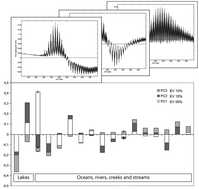当前位置:
X-MOL 学术
›
Anal. Methods
›
论文详情
Our official English website, www.x-mol.net, welcomes your feedback! (Note: you will need to create a separate account there.)
Examples of unwanted variation when characterising dissolved organic matter using direct injection electrospray mass spectrometry and chemometrics†
Analytical Methods ( IF 3.1 ) Pub Date : 2018-05-23 00:00:00 , DOI: 10.1039/c8ay00226f N. J. Nielsen 1, 2, 3, 4, 5 , P. Christensen 1, 2, 3, 4, 5 , C. Stedmon 5, 6, 7, 8 , J. H. Christensen 1, 2, 3, 4, 5
Analytical Methods ( IF 3.1 ) Pub Date : 2018-05-23 00:00:00 , DOI: 10.1039/c8ay00226f N. J. Nielsen 1, 2, 3, 4, 5 , P. Christensen 1, 2, 3, 4, 5 , C. Stedmon 5, 6, 7, 8 , J. H. Christensen 1, 2, 3, 4, 5
Affiliation

|
We describe a methodology for comparing and contrasting a large number of dissolved organic matter samples based on their electrospray ionization mass spectral characteristics. The analytical process and especially the electrospray process give rise to unwanted variation, which needs to be either mitigated, compensated for or monitored, and until now only few examples of multivariate comparison of large sets of dissolved organic matter mass spectral fingerprints where also unwanted variation is monitored have been published. The methodology comprises a tier of processes: (I) establishing a sample set including facilitator and quality control samples; (II) establishing pre-concentration/dilution factors to put samples to the same concentration domain; (III) chemical analysis by direct injection electrospray ionisation time-of-flight mass spectrometry; (IV) data pre-processing – normalisation and variable weighting – to emphasize variation relevant to the objective of the investigation; and (V) multivariate comparison and differentiation of a large number of samples by principal component analysis. The implementation of the methodology was demonstrated on two sample sets: terrestrial and oceanic dissolved organic matter from North America and Antarctica (set 1), and dissolved organic matter from Danish groundwaters (set 2). Samples were re-constituted from dry matter (set 1) or worked up directly (set 2). Artefacts originating from concentration effects were attempted removed by pre-concentration/dilution prior to chemical analysis, pre-concentration/dilution factors determined by either UV-(set 1) or negative mode ESI-MS screening (set 2). Normalisation factors and variable weights were established by use of facilitator sample sets. Artefacts related to unwanted variation induced by remaining concentration effects, sampling-, storage- and analytical processes are described and were monitored by independent quality control sample sets.
中文翻译:

使用直接注射电喷雾质谱和化学计量学表征溶解有机物时不想要的变化的示例†
我们基于其电喷雾电离质谱特性描述了一种用于比较和对比大量溶解有机物样品的方法。分析过程(尤其是电喷雾过程)会引起不想要的变化,需要对其进行缓解,补偿或监控,直到现在,只有少数几个对大量溶解有机物质谱指纹图谱进行多变量比较的示例,其中也存在不希望的变化。监视已发布。该方法包括一系列过程:(I)建立一个包括促进者和质量控制样本的样本集;(II)建立预浓缩/稀释因子,以将样品置于相同的浓度域;(III)通过直接注射电喷雾电离飞行时间质谱进行化学分析;(IV)数据预处理-归一化和可变权重-强调与调查目标有关的变化;(V)通过主成分分析对大量样本进行多变量比较和区分。在两个样本集上证明了该方法的实施:来自北美和南极洲的陆地和海洋溶解有机物(集合1)和来自丹麦地下水的溶解有机物(集合2)。从干物质中重新配制样品(组1)或直接进行后处理(组2)。尝试通过化学分析之前的预浓缩/稀释去除源自浓度效应的伪像,通过UV-(设置1)或负模式ESI-MS筛选(设置2)确定的预浓缩/稀释因子。归一化因子和可变权重通过使用促进者样本集来确定。描述了与由剩余浓度效应,采样,存储和分析过程引起的不想要的变化有关的伪影,并通过独立的质量控制样本集对其进行了监视。
更新日期:2018-05-23
中文翻译:

使用直接注射电喷雾质谱和化学计量学表征溶解有机物时不想要的变化的示例†
我们基于其电喷雾电离质谱特性描述了一种用于比较和对比大量溶解有机物样品的方法。分析过程(尤其是电喷雾过程)会引起不想要的变化,需要对其进行缓解,补偿或监控,直到现在,只有少数几个对大量溶解有机物质谱指纹图谱进行多变量比较的示例,其中也存在不希望的变化。监视已发布。该方法包括一系列过程:(I)建立一个包括促进者和质量控制样本的样本集;(II)建立预浓缩/稀释因子,以将样品置于相同的浓度域;(III)通过直接注射电喷雾电离飞行时间质谱进行化学分析;(IV)数据预处理-归一化和可变权重-强调与调查目标有关的变化;(V)通过主成分分析对大量样本进行多变量比较和区分。在两个样本集上证明了该方法的实施:来自北美和南极洲的陆地和海洋溶解有机物(集合1)和来自丹麦地下水的溶解有机物(集合2)。从干物质中重新配制样品(组1)或直接进行后处理(组2)。尝试通过化学分析之前的预浓缩/稀释去除源自浓度效应的伪像,通过UV-(设置1)或负模式ESI-MS筛选(设置2)确定的预浓缩/稀释因子。归一化因子和可变权重通过使用促进者样本集来确定。描述了与由剩余浓度效应,采样,存储和分析过程引起的不想要的变化有关的伪影,并通过独立的质量控制样本集对其进行了监视。



























 京公网安备 11010802027423号
京公网安备 11010802027423号